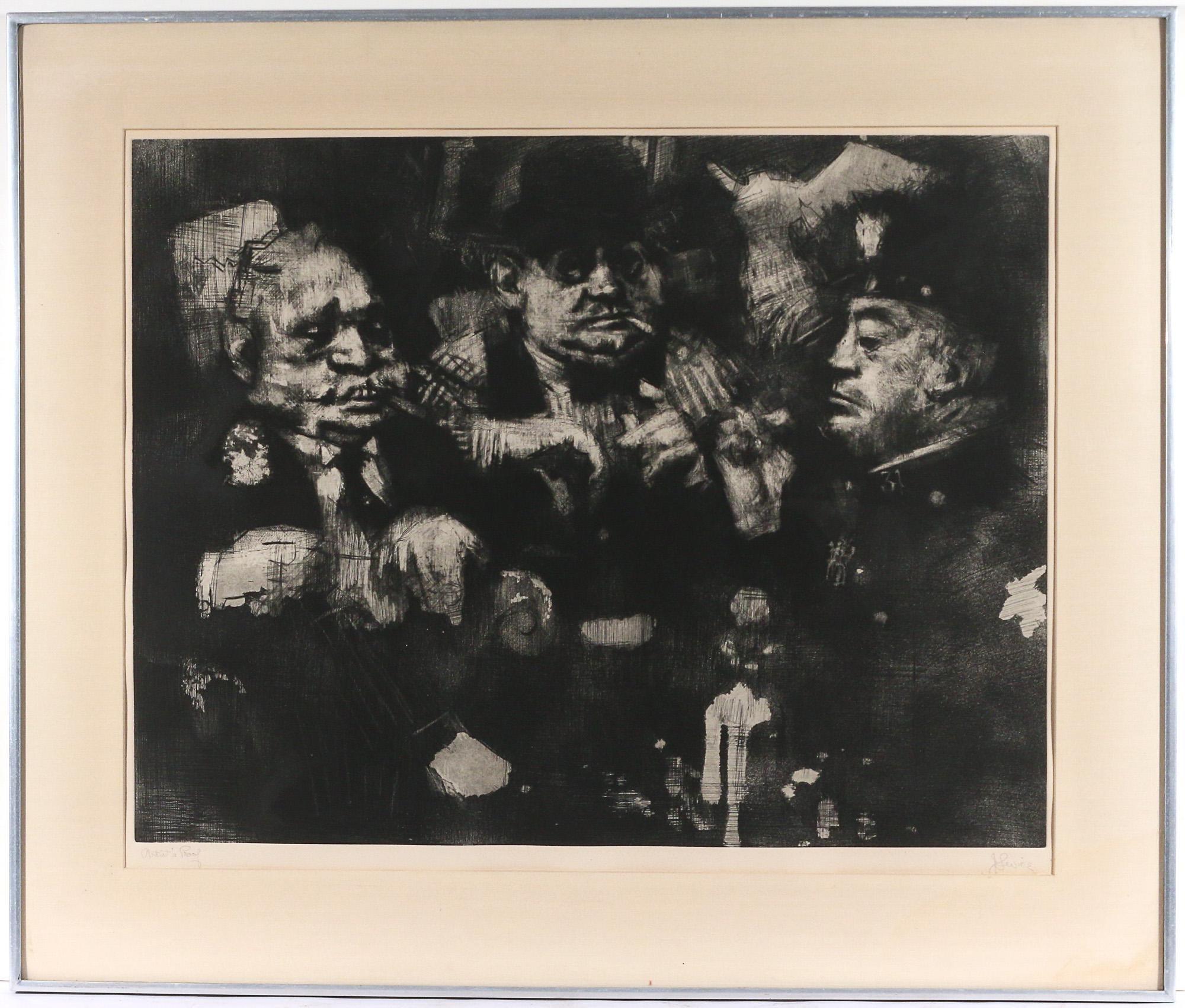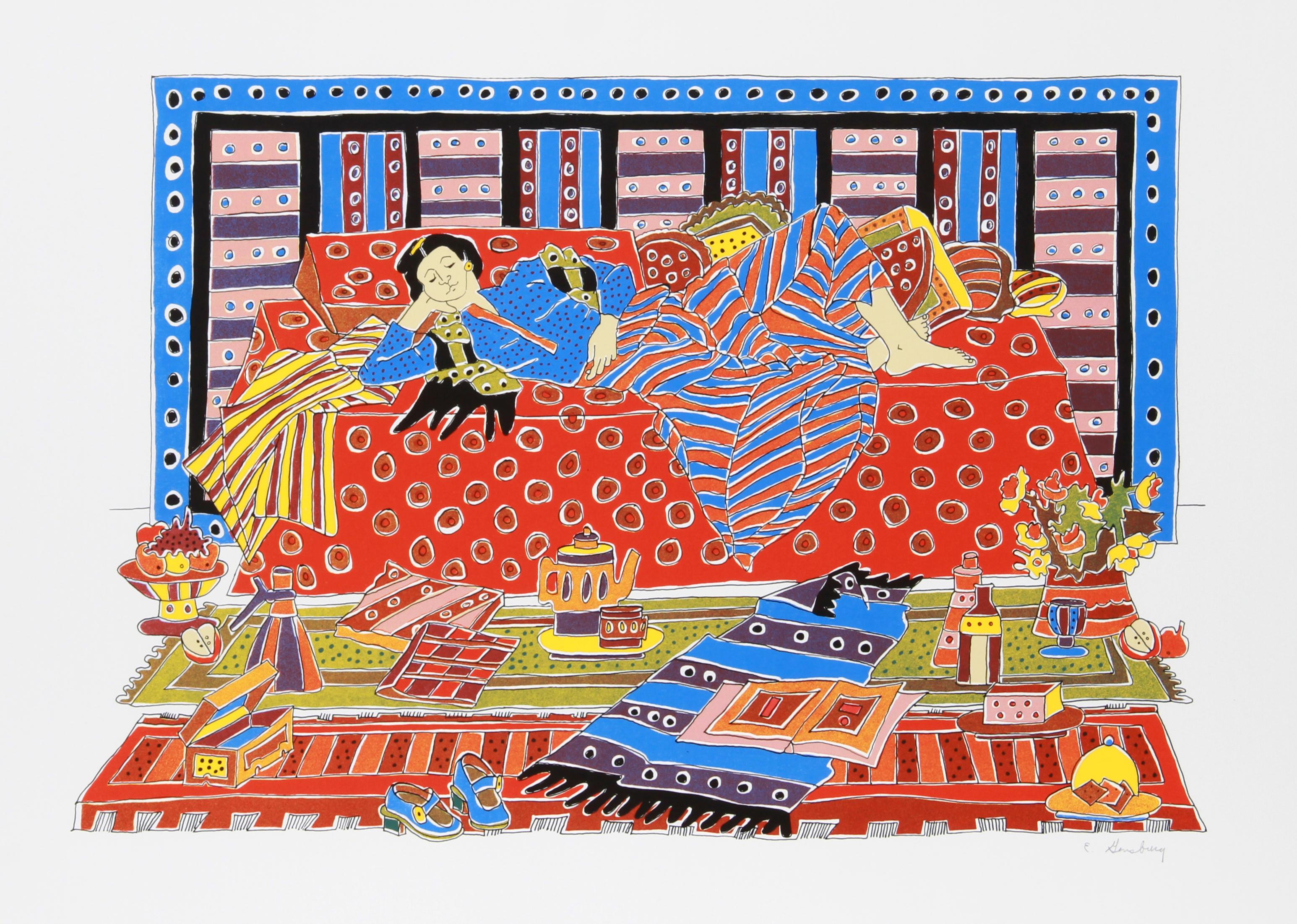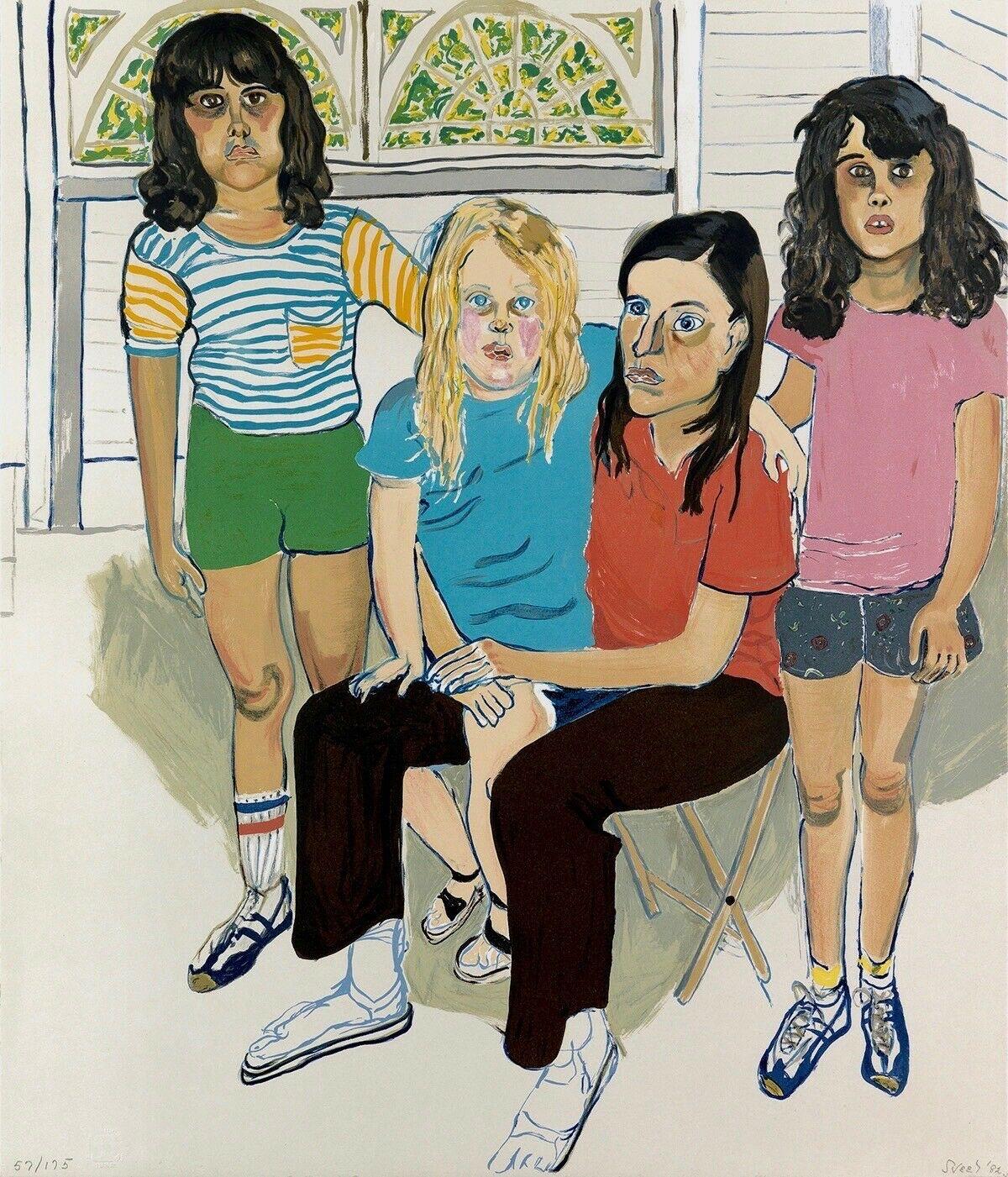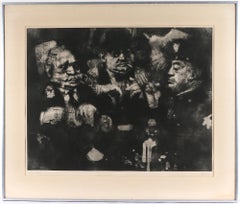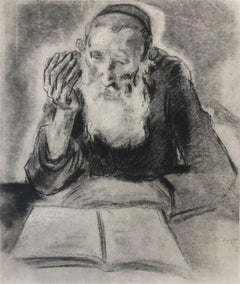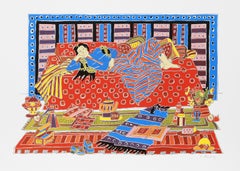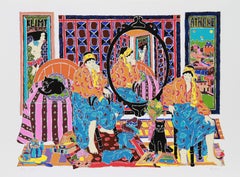
Judaica Jewish Shtetl Etching Hasidic Rabbi at Study Vintage Chassidic Art Print
View Similar Items
Want more images or videos?
Request additional images or videos from the seller
1 of 9
Paul JeffayJudaica Jewish Shtetl Etching Hasidic Rabbi at Study Vintage Chassidic Art Printc.1950's
c.1950's
About the Item
- Creator:Paul Jeffay (1898 - 1957, British)
- Creation Year:c.1950's
- Dimensions:Height: 14.9 in (37.85 cm)Width: 11.1 in (28.2 cm)
- Medium:
- Movement & Style:
- Period:
- Condition:hand made paper. edges ruffles and slightly toned - a few small indents in paper.
- Gallery Location:Surfside, FL
- Reference Number:1stDibs: LU3825051491
About the Seller
4.9
Platinum Seller
These expertly vetted sellers are 1stDibs' most experienced sellers and are rated highest by our customers.
Established in 1995
1stDibs seller since 2014
1,543 sales on 1stDibs
Typical response time: 1 hour
More From This SellerView All
- Judaica Jewish Shtetl Etching Yeshiva Talmudic Study Vintage Chassidic Art PrintBy Paul JeffayLocated in Surfside, FL"Qui a raison?" Chassidic boy, Yeshiva student with open book. Judaica, Jewish scenes from a ghetto. Saul Yaffie, a.k.a. Paul Jeffay, (1898–1957) was a Scottish Jewish artist. Known for his charming French street scenes as well as his judaica work. This is signed in the plate and dated 1931 in the print. This is done in a style similar to the works of the early Bezalel School artists Hermann Struck and Jakob Steinhardt. This lithograph, by artist Paul Jeffay depicts a Judaic Shtetl interior scene with great charm and sensitivity. Saul Yaffie was born in Blythswood, Glasgow on 29 April 1898. His mother was Kate Yaffie (née Karkonoski), and his father, Bernard Yaffie, was a master tailor. Like many Russian Jews, Kate and Bernard Yaffie fled persecution in Russia during a wave of anti-Jewish pogroms triggered by the assassination of Tsar Alexander II in 1881. Saul's father was naturalised as a British citizen by the time that Saul himself was three; a Bernard Yaffie is recorded as living at Abbotsford Place in the old Gorbals, where the young Saul spent the early years of his childhood. The Yaffies were not unique in their situation: the Gorbals was the centre of Scotland's Jewish community and home to a large proportion of Glasgow's immigrants throughout the early 20th century. Over time, there was a movement to some of the more affluent communities in Glasgow, such as Pollokshields and Garnethill, as many Jewish families gradually improved their social and economic situation. Like these, the Yaffies also experienced a time of good fortune, moving to a more agreeable address on Sinclair Drive, Cathcart as Bernard's tailoring business prospered. Saul attended day classes in drawing and painting, modelling, and life drawing at The Glasgow School of Art from 1912 to 1919. During the First World War, he was required to interrupt his studies to serve in the King's Own Scottish Borderers in 1916/17. Although subject to military conscription, Yaffie reached the rank of corporal during his service. Prior to his conscription Yaffie engaged in munitions work, something that was recorded in the GSA's student registers. The post-war economic depression that affected the country during the 1920s, also affected the Yaffie family directly: Bernard Yaffie's business suffered greatly, and the family eventually emigrated to Canada. Saul did not emigrate with his family, choosing instead to stay in Europe, and relocate to jazz age Paris where he continued his artistic practice. Now married, Saul sought to escape persecution in Europe by returning to the UK before the Second World War with his wife, Estusia. The two settled in Manchester, but returned to France after the war. In his memoires ‘Bronze in My Blood’, German-born sculptor Benno Schotz describes a Saul ‘Yaffe’, one of only three other Jewish students who attended The Glasgow School of Art at the time. (Schotz himself was exempt from joining the forces because he was ‘not yet a British subject’, and was engaged in war work in the drawing office of John Brown’s shipyards). On the outbreak of the war, Schotz writes, Yaffie won a poster competition to be displayed in Glasgow tramcars at the beginning of the 1914-18 war – his winning design depicted a woman with a child in her arms, fleeing from a fire behind her. While on leave from service, the young Saul told Schotz he had briefly been stationed in the same unit as Jewish American sculptor Jacob Epstein. This was most likely the 38th Battalion of the Royal Fusiliers, also known as ‘the Jewish Legion’, one of five Jewish battalions raised during WW1. ‘He told me how incongruous it was’, remembers Schotz, ‘to See Epstein scrubbing the floor of their hut, with a large diamond ring on his finger’. His work is included in the collection of the Ben Uri Museum in London along with Lucian Freud, David Bomberg, Mark Gertler, Josef Herman, Jankel Adler, Feliks Topolski...Category
20th Century Expressionist Interior Prints
MaterialsEtching
- American Modernist "Feast of Pure Reason" Aquatint Mezzotint Etching WPA ArtistBy Jack LevineLocated in Surfside, FLJack Levine, American, 1915–2010 The Feast of Pure Reason, 1970 Etching, mezzotint and aquatint on copper in black ink. 20 w. 25 in., sight overall: 27 x 31.75 in., matted. Depict...Category
1970s Expressionist Figurative Prints
MaterialsMezzotint, Etching, Aquatint
- Judaica Jewish Shtetl Etching Hasidic Rabbi at Study Vintage Chassidic PrintBy Paul JeffayLocated in Surfside, FLOlder Chassidic rabbi learning with open book, Judaica, Jewish scenes from a ghetto. Saul Yaffie, a.k.a. Paul Jeffay, (1898–1957) was a Scottish Jewish artist. Known for his charming French street scenes as well as his judaica work. This is signed in the plate and dated 1931 in the print. This is done in a style similar to the works of the early Bezalel School artists Hermann Struck and Jakob Steinhardt. This lithograph, by artist Paul Jeffay depicts a Judaic Shtetl interior scene with great charm and sensitivity. Saul Yaffie was born in Blythswood, Glasgow on 29 April 1898. His mother was Kate Yaffie (née Karkonoski), and his father, Bernard Yaffie, was a master tailor. Like many Russian Jews, Kate and Bernard Yaffie fled persecution in Russia during a wave of anti-Jewish pogroms triggered by the assassination of Tsar Alexander II in 1881. Saul's father was naturalised as a British citizen by the time that Saul himself was three; a Bernard Yaffie is recorded as living at Abbotsford Place in the old Gorbals, where the young Saul spent the early years of his childhood. The Yaffies were not unique in their situation: the Gorbals was the centre of Scotland's Jewish community and home to a large proportion of Glasgow's immigrants throughout the early 20th century. Over time, there was a movement to some of the more affluent communities in Glasgow, such as Pollokshields and Garnethill, as many Jewish families gradually improved their social and economic situation. Like these, the Yaffies also experienced a time of good fortune, moving to a more agreeable address on Sinclair Drive, Cathcart as Bernard's tailoring business prospered. Saul attended day classes in drawing and painting, modelling, and life drawing at The Glasgow School of Art from 1912 to 1919. During the First World War, he was required to interrupt his studies to serve in the King's Own Scottish Borderers in 1916/17. Although subject to military conscription, Yaffie reached the rank of corporal during his service. Prior to his conscription Yaffie engaged in munitions work, something that was recorded in the GSA's student registers. The post-war economic depression that affected the country during the 1920s, also affected the Yaffie family directly: Bernard Yaffie's business suffered greatly, and the family eventually emigrated to Canada. Saul did not emigrate with his family, choosing instead to stay in Europe, and relocate to jazz age Paris where he continued his artistic practice. Now married, Saul sought to escape persecution in Europe by returning to the UK before the Second World War with his wife, Estusia. The two settled in Manchester, but returned to France after the war. In his memoires ‘Bronze in My Blood’, German-born sculptor Benno Schotz describes a Saul ‘Yaffe’, one of only three other Jewish students who attended The Glasgow School of Art at the time. (Schotz himself was exempt from joining the forces because he was ‘not yet a British subject’, and was engaged in war work in the drawing office of John Brown’s shipyards). On the outbreak of the war, Schotz writes, Yaffie won a poster competition to be displayed in Glasgow tramcars at the beginning of the 1914-18 war – his winning design depicted a woman with a child in her arms, fleeing from a fire behind her. While on leave from service, the young Saul told Schotz he had briefly been stationed in the same unit as Jewish American sculptor Jacob Epstein. This was most likely the 38th Battalion of the Royal Fusiliers, also known as ‘the Jewish Legion’, one of five Jewish battalions raised during WW1. ‘He told me how incongruous it was’, remembers Schotz, ‘to See Epstein scrubbing the floor of their hut, with a large diamond ring on his finger’. His work is included in the collection of the Ben Uri Museum in London along with Lucian Freud, David Bomberg, Mark Gertler, Josef Herman, Jankel Adler, Feliks Topolski...Category
20th Century Expressionist Figurative Prints
MaterialsPaper, Etching
- Chris Ware New Yorker Cartoonist Limited Edition Thanksgiving Print NYCBy Chris WareLocated in Surfside, FLThis is one print – printed in full color on 15" x 20" heavy cream-colored paper. It is from a limited edition series of 175, the portfolio is hand numbered and hand signed by Chris Ware. the individual prints are not. The page with the hand signature is included here as a photo for reference only it is not included in this sale. Franklin Christenson "Chris" Ware (born December 28, 1967), is an American cartoonist known for his Acme Novelty Library series (begun 1994) and the graphic novel Jimmy Corrigan, the Smartest Kid on Earth (2000) and Building Stories (2012). His works explore themes of social isolation, emotional torment and depression. He tends to use a vivid color palette and realistic, meticulous detail. His lettering and images are often elaborate and sometimes evoke the ragtime era or another early 20th-century American design style. Ware often refers to himself in the publicity for his work in self-effacing, even withering tones. He is considered by some critics and fellow notable illustrators and writers, such as Dave Eggers, to be among the best currently working in the medium; Canadian graphic-novelist Seth has said, "Chris really changed the playing field. After him, a lot of [cartoonists] really started to scramble and go, 'Holy [expletive], I think I have to try harder.'" While still a sophomore at UT, Ware came to the attention of Art Spiegelman, who invited Ware to contribute to Raw, the influential anthology magazine Spiegelman was co-editing with Françoise Mouly. Ware has acknowledged that being included in Raw gave him confidence and inspired him to explore printing techniques and self-publishing. His Fantagraphics series Acme Novelty Library defied comics publishing conventions with every issue. Ware's art reflects early 20th-century American styles of cartooning and graphic design, shifting through formats from traditional comic panels to faux advertisements and cut-out toys. Stylistic influences include advertising graphics from that same era; newspaper strip cartoonists Winsor McCay (Little Nemo in Slumberland) and Frank King (Gasoline Alley); Charles Schulz's post-WWII strip Peanuts and the cover designs of ragtime-era sheet music. Ware has spoken about finding inspiration in the work of artist Joseph Cornell and cites Richard McGuire's strip Here as a major influence on his use of non-linear narratives. He is one of the great practitioners who have elevated the graphic novel style along with, Shepard Fairey, Ben Katchor and Robert Crumb. Quimby the Mouse was an early character for Ware and something of a breakthrough. Rendered in the style of an early animation character like Felix the Cat, Quimby the Mouse is perhaps Ware's most autobiographical character. Ware's Building Stories was serialized in a host of different venues. It first appeared as a monthly strip in Nest Magazine. Installments later appeared in a number of publications, including The New Yorker, Kramer's Ergot, and most notably, the Sunday New York Times Magazine. Building Stories appeared weekly in the New York Times Magazine from September 18, 2005 until April 16, 2006. A full chapter was published in Acme Novelty Library, number 18. Another installment was published under the title "Touch Sensitive" as a digital app released through McSweeneys. The entire narrative was published as a boxed set of books by Pantheon in October 2012. Ware was commissioned by Chip Kidd to design the inner machinations of the bird on the cover of Haruki Murakami's novel The Wind-Up Bird Chronicle. In 2011, Ware created the poster for the U.S. release of the 2010 Palme d'Or winning film Uncle Boonmee Who Can Recall His Past Lives by Thai director Apichatpong Weerasethakul. Awards and honors Over the years his work garnered several awards, including the 1999 National Cartoonists Society's Award for Best Comic Book for Acme Novelty Library and Award for Graphic Novel for Building Stories. Ware has won numerous Eisner Awards and multiple Harvey Awards. In 2002, Ware became the first comics artist to be invited to exhibit at Whitney Museum of American Art biennial exhibition. With Will Eisner, Jack Kirby, Harvey Kurtzman, Robert Crumb and Gary Panter, Ware was among the artists honored in the exhibition "Masters of American Comics" at the Jewish Museum in New York City, New York, from September 16, 2006 to January 28, 2007. His work was the subject of solo exhibitions at the Museum of Contemporary Art, Chicago in 2006 and at the University of Nebraska's Sheldon Museum of Art, in 2007. Many famous artists have done covers for the New Yorker Magazine including, Saul Steinberg, Maira Kalman, Art Spiegelman, Francoise Mouly, Charles Addams, Peter Arno, Roz Chast, Ed Koren...Category
Early 2000s American Modern Figurative Prints
MaterialsColor
- Chris Ware New Yorker Cartoonist Limited Edition Thanksgiving Print NYCBy Chris WareLocated in Surfside, FLThis is one print – printed in full color on 15" x 20" heavy cream-colored paper. It is from a limited edition series of 175, the portfolio is hand numbered and hand signed by Chris Ware. the individual prints are not. The page with the hand signature is included here as a photo for reference only it is not included in this sale. Franklin Christenson "Chris" Ware (born December 28, 1967), is an American cartoonist known for his Acme Novelty Library series (begun 1994) and the graphic novel Jimmy Corrigan, the Smartest Kid on Earth (2000) and Building Stories (2012). His works explore themes of social isolation, emotional torment and depression. He tends to use a vivid color palette and realistic, meticulous detail. His lettering and images are often elaborate and sometimes evoke the ragtime era or another early 20th-century American design style. Ware often refers to himself in the publicity for his work in self-effacing, even withering tones. He is considered by some critics and fellow notable illustrators and writers, such as Dave Eggers, to be among the best currently working in the medium; Canadian graphic-novelist Seth has said, "Chris really changed the playing field. After him, a lot of [cartoonists] really started to scramble and go, 'Holy [expletive], I think I have to try harder.'" While still a sophomore at UT, Ware came to the attention of Art Spiegelman, who invited Ware to contribute to Raw, the influential anthology magazine Spiegelman was co-editing with Françoise Mouly. Ware has acknowledged that being included in Raw gave him confidence and inspired him to explore printing techniques and self-publishing. His Fantagraphics series Acme Novelty Library defied comics publishing conventions with every issue. Ware's art reflects early 20th-century American styles of cartooning and graphic design, shifting through formats from traditional comic panels to faux advertisements and cut-out toys. Stylistic influences include advertising graphics from that same era; newspaper strip cartoonists Winsor McCay (Little Nemo in Slumberland) and Frank King (Gasoline Alley); Charles Schulz's post-WWII strip Peanuts and the cover designs of ragtime-era sheet music. Ware has spoken about finding inspiration in the work of artist Joseph Cornell and cites Richard McGuire's strip Here as a major influence on his use of non-linear narratives. He is one of the great practitioners who have elevated the graphic novel style along with, Shepard Fairey, Ben Katchor and Robert Crumb. Quimby the Mouse was an early character for Ware and something of a breakthrough. Rendered in the style of an early animation character like Felix the Cat, Quimby the Mouse is perhaps Ware's most autobiographical character. Ware's Building Stories was serialized in a host of different venues. It first appeared as a monthly strip in Nest Magazine. Installments later appeared in a number of publications, including The New Yorker, Kramer's Ergot, and most notably, the Sunday New York Times Magazine. Building Stories appeared weekly in the New York Times Magazine from September 18, 2005 until April 16, 2006. A full chapter was published in Acme Novelty Library, number 18. Another installment was published under the title "Touch Sensitive" as a digital app released through McSweeneys. The entire narrative was published as a boxed set of books by Pantheon in October 2012. Ware was commissioned by Chip Kidd to design the inner machinations of the bird on the cover of Haruki Murakami's novel The Wind-Up Bird Chronicle. In 2011, Ware created the poster for the U.S. release of the 2010 Palme d'Or winning film Uncle Boonmee Who Can Recall His Past Lives by Thai director Apichatpong Weerasethakul. Awards and honors Over the years his work garnered several awards, including the 1999 National Cartoonists Society's Award for Best Comic Book for Acme Novelty Library and Award for Graphic Novel for Building Stories. Ware has won numerous Eisner Awards and multiple Harvey Awards. In 2002, Ware became the first comics artist to be invited to exhibit at Whitney Museum of American Art biennial exhibition. With Will Eisner, Jack Kirby, Harvey Kurtzman, Robert Crumb and Gary Panter, Ware was among the artists honored in the exhibition "Masters of American Comics" at the Jewish Museum in New York City, New York, from September 16, 2006 to January 28, 2007. His work was the subject of solo exhibitions at the Museum of Contemporary Art, Chicago in 2006 and at the University of Nebraska's Sheldon Museum of Art, in 2007. Many famous artists have done covers for the New Yorker Magazine including, Saul Steinberg, Maira Kalman, Art Spiegelman, Francoise Mouly, Charles Addams, Peter Arno, Roz Chast, Ed Koren...Category
Early 2000s American Modern Figurative Prints
MaterialsColor
- Girl in Ballerina Dress (Thonet Chair) Color Lithograph, American ModernistBy Philip PearlsteinLocated in Surfside, FLGirl in Ballerina Dress, c. 1970 Color lithograph printed on wove paper, hand signed in pencil and numbered 22/75, with the inkstamp of the publisher, Landfall Press, Chicago (they have published an eclectic list of many important artists including Christo, Judy Chicago, David Levinthal and Jack tworkov to name a few.) Philip Pearlstein is an influential American painter best known for Modernist Realism nudes. Cited by critics as the preeminent figure painter of the 1960s to 2000s, he led a revival in realist art. He is a Distinguished Professor Emeritus with paintings in the collections of over 70 public art museums. Philip M. Pearlstein was born on May 24, 1924 in Pittsburgh, PA. He attended Saturday morning classes at Pittsburgh's Carnegie Museum of Art. In 1942, at the age of 18, two of his paintings won a national competition sponsored by Scholastic Magazine, and were reproduced in color in Life magazine. In 1942, he enrolled at Carnegie Institute of Technology's art school, in Pittsburgh, where he painted two portraits of his parents now held by the Carnegie Museum of Art, but after one year he was drafted by the US Army to serve during World War II. He was initially assigned to the Training Aids Unit at Camp Blanding, Florida, where he produced charts, weapon assembly diagrams and signs. In this role, he learned printmaking and the screenprinting process, and subsequently was stationed in Italy making road signs. While in Italy, he took in as much renaissance art as was accessible in Rome, Florence, Venice and Milan, and also produced numerous drawings depicting life in the Army. In 1946, sponsored by the GI Bill, he returned to Carnegie Institute, and first met Andy Warhol, who was attracted to Pearlstein because of his notoriety in the school, having been featured in Life magazine. During the summer of 1947, the three rented a barn as a summer studio. Immediately after graduating in June 1949 with a BFA, Pearlstein and Warhol moved to New York City, at first sharing an eighth-floor walkup tenement apartment on St. Mark's Place at Avenue A. He was eventually hired by Czech designer Ladislav Sutnar, mainly doing industrial catalog work, while Warhol immediately found work illustrating department store catalogs presaging Pop Art. In April 1950, they moved to 323 W. 21st Street, into an apartment rented by Franziska Marie Boas, who ran a dance class on the other side of the room. During this time, Pearlstein painted a portrait of Warhol, now held by the Whitney Museum of American Art. In 1950, Philip Pearlstein married Dorothy Cantor, with Andy Warhol in the wedding party...Category
1970s American Realist Figurative Prints
MaterialsLithograph
You May Also Like
- Lady RoseLocated in Ibadan, OyoLady Rose is an original painting by Lawal Ibrahim. Ibrahim created Lady Rose with a Colored pen, watercolor, and fabrics on 24W by 36H inches of paper. "Lady Rose" is a captivating...Category
21st Century and Contemporary Expressionist Figurative Prints
MaterialsFabric, Paper, Watercolor, Ballpoint Pen
- Women of Intellect #6, Lithograph by Estelle GinsburgLocated in Long Island City, NYArtist: Estelle Ginsburg, American Title: Women of Intellect #6 Year: 1978 Medium: Lithograph, signed and numbered in pencil Edition: 150 Size: ...Category
1970s Expressionist Figurative Prints
MaterialsLithograph
- Klimt, Lithograph by Estelle GinsburgLocated in Long Island City, NYKlimt Estelle Ginsburg, American Date: circa 1979 Screenprint, signed and numbered in pencil Edition of 500, AP 50 Size: 21.5 in. x 29 in. (54.61 cm x 73.66 cm)Category
1970s Expressionist Figurative Prints
MaterialsLithograph
- The Family, Alice NeelBy Alice NeelLocated in Fairfield, CTArtist: Alice Neel (1900-1984) Title: The Family Year: 1982 Medium: Lithograph on Arches paper Edition: 57/175, plus proofs Size: 31.25 x 27 inches Condition: Excellent Inscription: ...Category
1980s Expressionist Figurative Prints
MaterialsLithograph
$11,600 Sale Price20% Off - Mujere IIBy Raul SoldiLocated in San Francisco, CAThis artwork "Mujere II" c.1960 is an original color silkscreen by noted Argentinian artist Raul Soldi, 1905-1994. It is hand signed and numbered 93/150 in pencil by the artist. The image size is 13.5 x 20.5 inches, sheet size is 19.75 x 22.75 inches. The colors are fresh and bright, it have a 0.85 inches restored tear at the lower margin (see picture #6 for detail) some paper rubs on the verso, not visible from the front. otherwise in good condition. About the artist: Raúl Soldi was born in Buenos Aire in 1905. He was an argentine plastic artist of recognized international experience. In 1920 he began drawing and painting. He makes reproductions of Quinquela Martín...Category
Mid-20th Century Expressionist Figurative Prints
MaterialsScreen
- MujereBy Raul SoldiLocated in San Francisco, CAThis artwork "Mujere" c.1960 is an original color silkscreen by noted Argentinian artist Raul Soldi, 1905-1994. It is hand signed and numbered 12/15 P.A in pencil by the artist. The image size is 22.75 x 17 inches, sheet size is 26.65 x 21.5 inches. It is in very good condition, colors are fresh and bright. About the artist: Raúl Soldi was born in Buenos Aire in 1905. He was an argentine plastic artist of recognized international experience. In 1920 he began drawing and painting. He makes reproductions of Quinquela Martín...Category
Mid-20th Century Expressionist Figurative Prints
MaterialsScreen
$1,200

